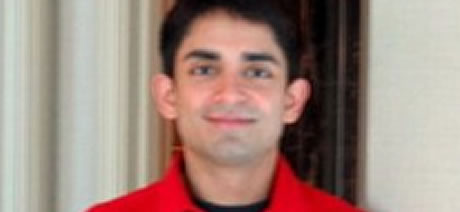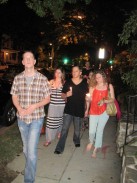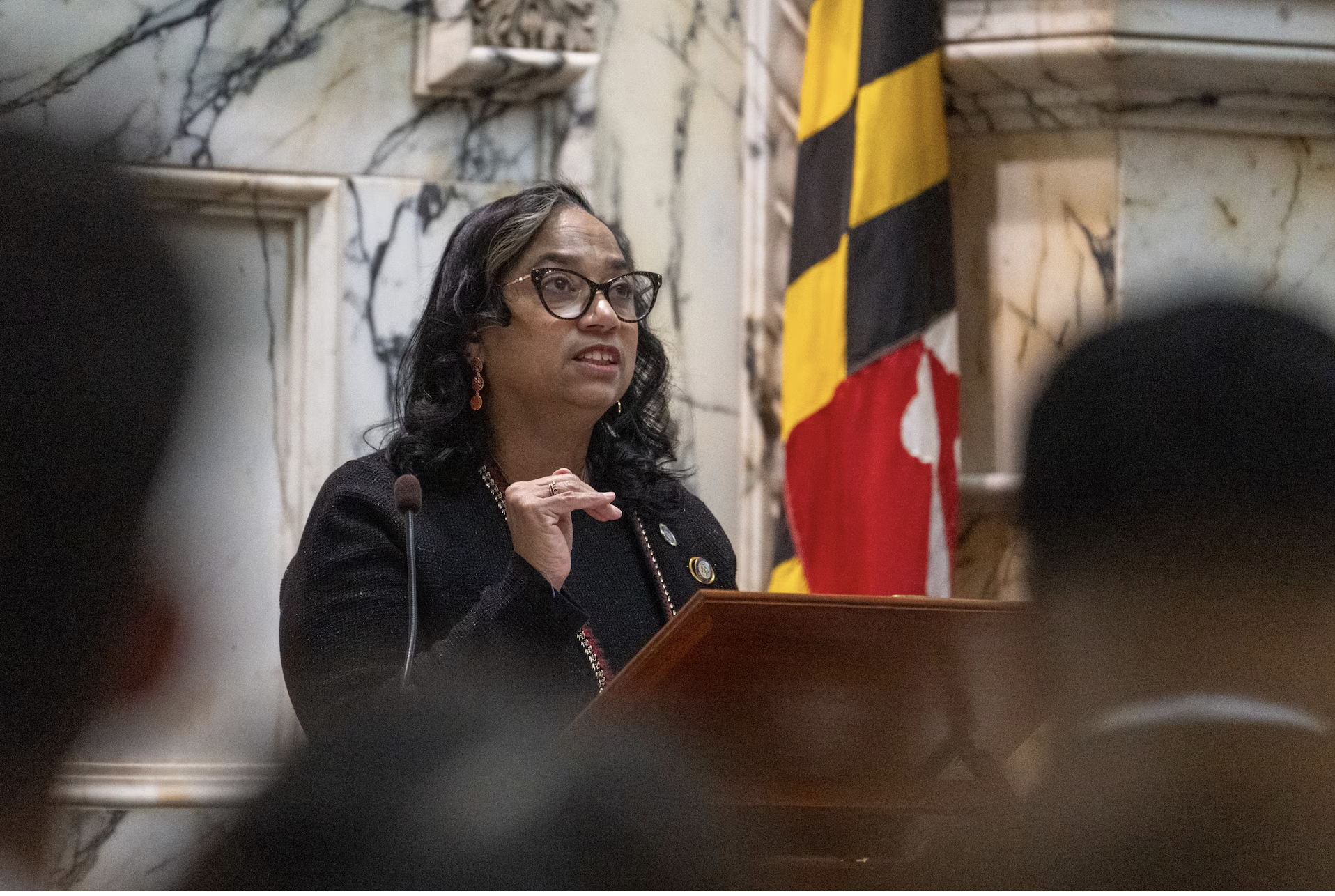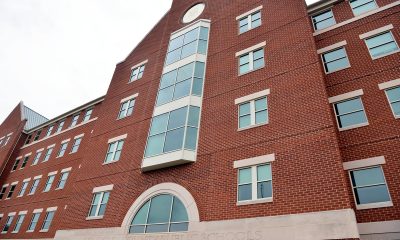Local
Dupont Circle vigil for slain engineer, theater director draws over 200
Friends read from Shakespeare plays to honor life of Gaurav Gopalan


Participants of a candle light vigil for slain aeorspace engineer and theater director Gaurav Gopalan arriving at a memorial site in Columbia Heights near where his body was found after they walked from Dupont Circle. (Washington Blade photo by Lou Chibbaro)
More than 200 people turned out Sunday night in Dupont Circle for a candle light vigil in honor of Gaurav Gopalan, a 35-year-old gay aerospace engineer and theater director who was found dead Sept. 10 on a sidewalk near where he lived in the city’s Columbia Heights section.
Police have ruled the death a homicide and said Gopalan died from blunt force trauma to the head. Police say they have no suspects and no known motive for the murder.
Transgender activists have expressed concern that Gopalan might have been targeted for his gender identity because he was found dressed in women’s clothes and wearing facial makeup.
Nearly a dozen friends and community activists spoke at the vigil, with most reading excerpts from Shakespeare plays and sonnets to pay tribute to what they said was Gopalan’ love of Shakespeare’s works.
Many of the friends said they met Gopalan through various theater companies and groups, and worked with him on productions of Shakespeare plays, where he served as an assistant director.
“Gaurav touched so many souls in D.C.,” said Jason McCool, who collaborated with Gopalan on the production of Shakespeare plays. “He was a bright ray of positive energy and I will never, ever forget what he contributed to my life. To me, his spirit will remain forever alive and present.”
Gopalan’s partner, Bob Shaeffer, thanked organizers of the vigil and those who attended for their support of him during a trying time.
“This would have pleased Gaurav,” he said. “Gaurav changed my life. There wasn’t a day we were together that we didn’t say we loved each other.”
Shaeffer called on the community to apply pressure on D.C. police to “do more” to find out who killed his partner and bring that person to justice.
Other speakers included D.C. Council member Jim Graham (D-Ward 1), who represents the Columbia Heights neighborhood where Gopalan was found dead; transgender activist Earline Budd; Shiva Subbaraman, director of Georgetown University’s LGBTQ Resource Center and a friend of Gopalan’s; and a representative of the South Asian LGBT group Khush D.C., who didn’t identify himself. McCool read a letter from D.C. Congressional Delegate Eleanor Homes Norton praising Gopalan for his contribution to D.C. both as an aerospace engineer and a theater director.
“We are determined to get to the bottom of this,” Graham told the gathering. “We are determined to bring this killer to justice and to support everyone in the District of Columbia affected by this.”
At the conclusion of the vigil, participants marched from Dupont Circle to Columbia Heights, where they gathered on the 2600 block of 11th Street, N.W., at the site where Gopalan was found unconscious shortly after 5 a.m. on Sept. 10.
The site is marked by a large photo of Gopalan that friends attached to a tree and by flowers placed at the foot of the tree. Virgil participants, who had walked more than two miles from Dupont Circle, placed lit candles next to the flowers, creating a glowing memorial on the sidewalk.
With the candles flickering before him, McCool read from a theater program note that Gopalan wrote in connection with one of the Shakespeare plays that Gopalan played a role in producing in the D.C. area:
“There is no judgment…only light and dark, only truth and ignorance,” McCool quoted Gopalan as saying. “What is true is good; evil is quite simply ignorance.”
Local
LGBTQ, LGBTQ-friendly congregations to hold holiday services
Bet Mishpachah’s Hanukkah service to take place on Friday

LGBTQ and LGBTQ-friendly congregations in D.C. will hold services and other events throughout the holiday season.
Bet Mishpachah on Friday will hold its Sparks in the Dark Happy Hour at Spark Social on 14th Street from 5:30-7:30 p.m. It’s Chanuka Shabbat Service will begin at the Edlavitch DC Jewish Community Center (1529 16th St., N.W.) at 8 p.m.
Hanukkah began on Sunday and will end on Dec. 22.
Two gunmen on Sunday killed 15 people and injured more than two dozen others when they opened fire at a Hanukkah celebration on Sydney’s Bondi Beach.
Jake Singer-Beilin, Bet Mishpachah’s chief rabbi, in a Facebook post mourned the victims.
“We grieve for the victims and send heartfelt prayers of healing for those who were wounded,” he wrote.
“This Chanuka, our lights will shine brightly in the darkness, but our hearts will be heavy with mourning for those who were murdered on Bondi Beach while observing what should have been a joyous day,” added Singer-Beilin. “We will still celebrate our Festival of Lights and we will commit ourselves to illuminating and repairing our broken world. Let us channel the bravery of the Maccabees who found hope where there seemed to be none, and who fought to create a better future. We must do the same.”
LGBTQ Catholic group to hold annual Christmas Day Mass
Dignity Washington’s Christmas Day Mass will take place at St. Margaret’s Episcopal Church (1820 Connecticut Ave., N.W.) on Dec. 25 from 6-7 p.m. Parishioners can attend in person or watch it online via Facebook.
The Metropolitan Community Church of Washington D.C.’s Christmas Eve service will take place at the church (474 Ridge St., N.W., on Dec. 24 at 6 p.m.
St. Thomas Episcopal Church (1517 18th St., N.W.) in Dupont Circle will hold its Christmas Eve Festival Eucharist from 5-6 p.m. A Christmas Eve dinner will take place in the Parish Hall from 6-8:30 p.m. The church’s Christmas Eve Festival Eucharist will occur on Dec. 25 from 10-11 a.m.
Washington National Cathedral throughout the holiday season has a number of services and events scheduled. These include the virtual Gospel Christmas Service on Dec. 21 from 6-7:30 p.m., the Family Christmas Service on Dec. 23 from 11 a.m. to noon, the Christmas Eve Festival Holy Eucharist on Dec. 24 from 10-11:45 p.m., and the Christmas Day Festival Holy Eucharist on Dec. 25 from 11:15 a.m. to 12:45 p.m.
The Foundry United Methodist Church (1500 16th St., N.W.) in Dupont Circle will hold its Christmas Eve Family Service on Dec. 24 at 4:30 p.m. Its Carols and Candlelight Service will take place at 8 p.m.
Smithsonian Anacostia Community Museum to celebrate Kwanzaa
The Smithsonian Anacostia Community Museum (1901 Fort Place S.E.) in Anacostia will mark the first day of Kwanzaa on Dec. 26 with storytelling and drumming with Mama Ayo and Baba Ras D from noon to 2 p.m. The museum will hold a series of other events through the 6-day celebration of African American culture that ends on Jan. 1.
The Creative Suitland Arts Center (4719 Silver Hill Road) in Suitland, Md., on Friday will hold their Almost Kwanzaa: A Creative Kind of Holiday event from 6-8:30 p.m.
Maryland
Joseline Peña-Melnyk elected Md. House speaker
Family immigrated to New York City from the Dominican Republic

By PAMELA WOOD | Moments after being elected speaker of the Maryland House of Delegates Tuesday, state Del. Joseline Peña-Melnyk stood before the chamber and contemplated her unlikely journey to that moment.
Born in the Dominican Republic, the Peña family lived in a small wooden house with a leaky tin roof and no indoor plumbing. Some days, she said, there was no food to eat.
When she was 8 years old, the family immigrated to New York City, where Peña-Melnyk was dubbed “abogadito” or “little lawyer” for helping her mother and others by translating at social services offices.
The rest of this article can be read on the Baltimore Banner’s website.
District of Columbia
D.C. students need academic support, diverse connections for economic mobility
Region offers array of resources for families in need of assistance

Education is the blueprint of good economic mobility.
But when students aren’t set up with the proper resources to secure a quality education, it’s often low-income families that suffer the most, For Love of Children (FLOC) Executive Director LaToya Clark said. Children from low-income families on average grow up to earn $25,600 annually, according to Opportunity Insights.
D.C. families need better economic mobility, and experts say that starts with kids getting an education and breaking generational poverty cycles. Students without a high school diploma earn $738 per week on average, while those who graduated high school earn roughly $930 per week, according to the U.S. Bureau of Labor Statistics. Contrarily, those with bachelor’s degrees earn about $1,543 per week.
Students from low-income backgrounds have fewer financial advantages on their paths to securing an education, and hardships faced by public schools make it difficult for them to catch up, Clark said.
From local financial and educational assistance programs to strengthening diversity among educators, here are a few ways researchers and advocates are fighting for better economic mobility in D.C. schools.
Student assistance programs
For many students, falling behind academically is because of circumstances outside of their control, Clark said.
She said teacher shortages, large classrooms and scarce funding can lead to an educational environment not fully equipped to set students on the right path. A one-dimensional education can then hinder future professional opportunities and give students limited economic mobility.
That’s where local organizations like FLOC come in –– to fill in the academic and social gaps often left open by schools.
Clark said FLOC has multiple services that give underserved students a more individualized academic experience. For the Neighborhood Tutoring Program, students are assessed at the grade level at which they’re performing, not what grade they are in. They’re then matched with a volunteer –– ranging from college students to retirees –– who follows a curriculum that matches the student’s performance level.
There’s also the Pathways Forward Program, an afterschool opportunity for D.C. youth in 7th to 12th grades designed to increase high school graduation rates. The program supports those at risk of academic failure to find a successful way forward, and those in 10th to 12th grades to prepare for graduation or transition to postsecondary programs. Both Neighborhood Tutoring and Pathways Forward are free.
“Everything we offer is designed to close achievement gaps, help our students boost their confidence and ensure young people have the skills and support that they need to succeed in schools and beyond,” Clark said.
And that design is working for students. Clark recalled a young girl who was the oldest of six who felt a need to help her mom take care of her siblings. She was falling behind in school until she found FLOC. The girl credited her ability to go to college and find a professional job to FLOC’s individualized and accessible approach to education.
FLOC is a reliable resource for D.C. youth to get academic help, but there are numerous other organizations working to close educational gaps and improve the future economic mobility of students.
Minds Matter D.C. helps underserved students find accessible pathways to prepare for and succeed in college. The organization offers mentoring, SAT prep, access to summer enrichment programs and guidance through the college application and financial aid process.
The work Minds Matter does addresses a disproportionate statistic: While roughly 89% of students from “well-off” families attend college, only 51% of students from low-income families do so, according to a report published by Brookings. Minds Matter reported that 100% of its students attended a four-year college or university.
The D.C. Schools Project, a program of the Center for Social Justice, offers academic help and English-language tutoring for low-income and immigrant families. Each semester, roughly 60 tutors assist about 100 students, their families, and other D.C. immigrants.
D.C. CAP Scholars has a mission to connect youth with financial and academic opportunities that will help them succeed in college. Registration is now open for the organization’s Ward 7 & 8 scholarship, a $12,000 annual scholarship for students who attended high school in those D.C. wards. Those areas encompass communities such as Congress Heights, Deanwood and Anacostia, which are some of the city’s poorest areas.
RISE offers tutoring and college mentoring to underserved populations. Its primary focus is on opportunity academies, including the three in D.C.: Ballou STAY, Luke C. Moore and Garnet-Patterson STAY. These academies are “second chance” schools for students who didn’t complete high school on a traditional timeline.
RISE Executive Director Ricardo Cooper said the organization offers real-time tutors for students in these academies through its Keep Up Tutoring program. RISE also provides summer literacy “bootcamps” and college prep for underserved students.
As a native Washingtonian, Cooper said he wishes opportunities like RISE were available to him as a kid. That’s why it’s so special for him to lead the organization and help D.C. youth rise above the academic and economic barriers he used to face.
“We know that going to college and getting a degree makes you more money,” Cooper said. “Being able to have these programs to support youth in school, to make sure that they feel confident once they graduate high school, to go to college, to feel confident in completing their coursework and just understanding the material is important to raise that poverty line.”
While these programs are crucial to many students’ success, Matthew Shirrell, associate professor of educational leadership at George Washington University, said there are many fundamental solutions to supporting kids that schools should recognize.
Diverse learning opportunities
Shirrell’s research has identified a key link to the positive relationships between teachers and students: diversity.
“Having a more diverse teaching workforce would certainly benefit all students, because it’s like their teachers having access to a library with a whole bunch of different perspectives,” Shirrell said.
He said teachers have a continuously growing list of responsibilities not just academically, but in dealing with social and emotional issues that students bring to school. By having a diverse team of educators in each school, teachers are better equipped to connect with students to turn potential barriers into new pathways.
But achieving this is about more than championing diversity –– it’s a way for students to secure better futures and stay out of the criminal justice system, Shirrell said.
Shirrell pointed to the idea of “exclusionary discipline.” In his research, Shirrell found that Black and LatinX students were significantly less likely to be suspended from school when they had teachers who shared their racial or ethnic background.
Teachers of different backgrounds than their students tend to rely on harsh disciplinary action, when in reality the situation could come down to cultural misunderstandings or misconceptions, Shirrell said.
In the long run, this disciplinary bias can disproportionately impact underserved communities. Shirrell said relentless discipline can lead to the students making poor decisions outside of school and potentially ending up in the criminal justice system.
At such a formative age, students need the support, understanding and guidance that only a diverse population of educators can bring.
“You really can’t get that from a book,” Shirrell said. “The best way to learn that is from working alongside somebody who you know is doing things differently than you. There’s tremendous value to having a diverse workforce, whether that be racial, linguistic or economic.”
Securing an education from open-minded teachers is especially important in underserved pockets of D.C., such as Wards 7 and 8. D.C. youth can experience completely different lives and opportunities just by living around the block. Diverse educators can help fill social gaps, but having students from different economic backgrounds share a classroom pushes them to see different points of views and develop their critical thinking skills, Shirrell said.
Luckily, that sentiment rings true in D.C., a city with high social capital –– or the likelihood of low-income people and high-income people becoming friends or crossing paths. About 50% of the friends of low-income people have high incomes, and low-income people are only 4.7% less likely to friend high-income people they meet, according to Opportunity Insights.
Though there’s never one simple solution in growing economic mobility for students and their families, Cooper, the RISE executive director, said having educators who embody multiple perspectives –– as well as ensure students are aware of the financial and academic support programs available to them –– are strong ways to set a child on a brighter financial and professional path.
“There are a lot of factors that also go along with [improving economic mobility], but chances are better once students feel confident in who they are, confident in what they can do and go to college and excel,” Cooper said.
This article is part of a national initiative exploring how geography, policy, and local conditions influence access to opportunity. Find more stories at economicopportunitylab.com.
-

 Virginia5 days ago
Virginia5 days agoDOJ seeks to join lawsuit against Loudoun County over trans student in locker room
-

 Photos4 days ago
Photos4 days agoPHOTOS: The Holiday Show
-

 Books4 days ago
Books4 days agoThe best books to give this holiday season
-

 Health4 days ago
Health4 days agoChoose U ambassadors share lived experiences with HIV, personal reflections, and insights




















